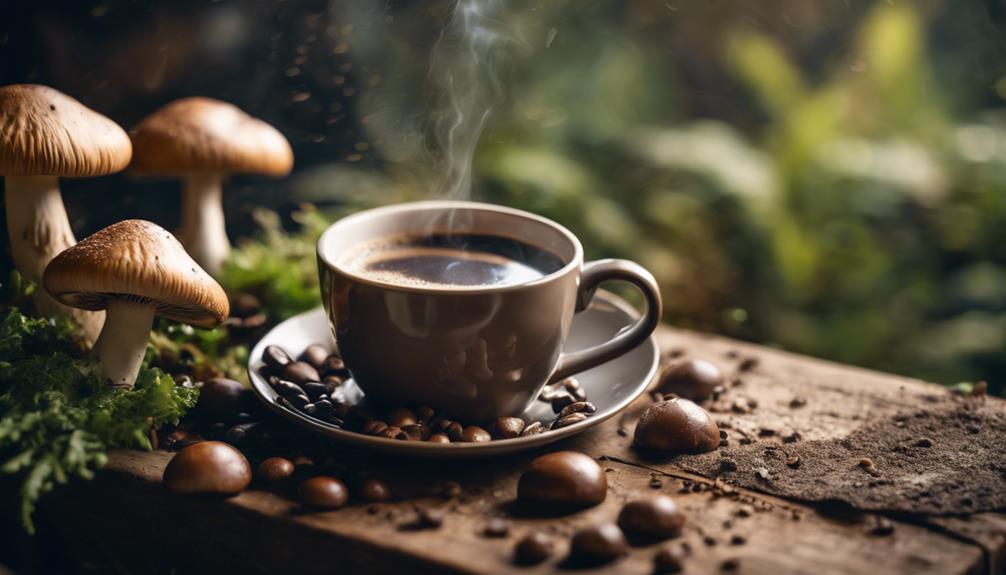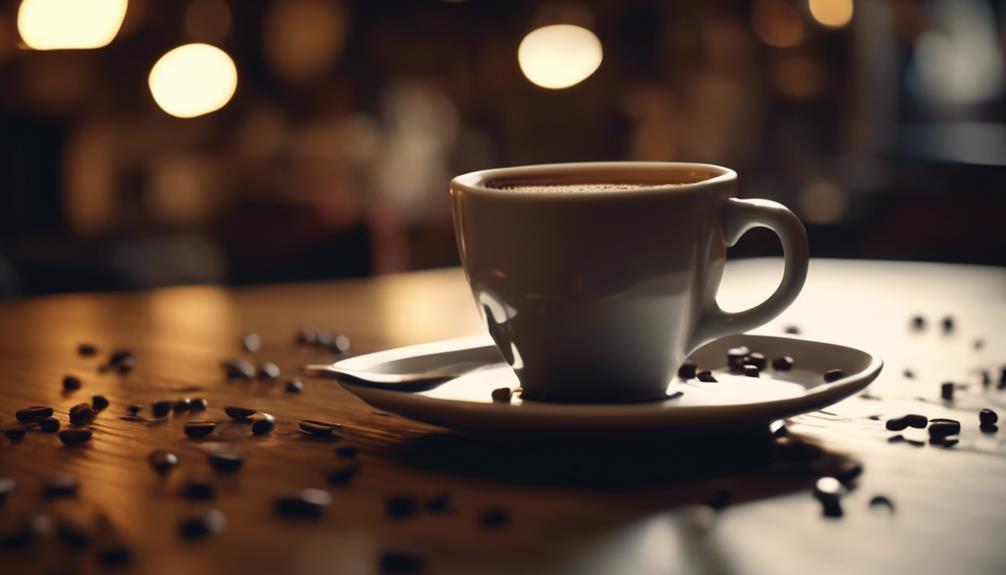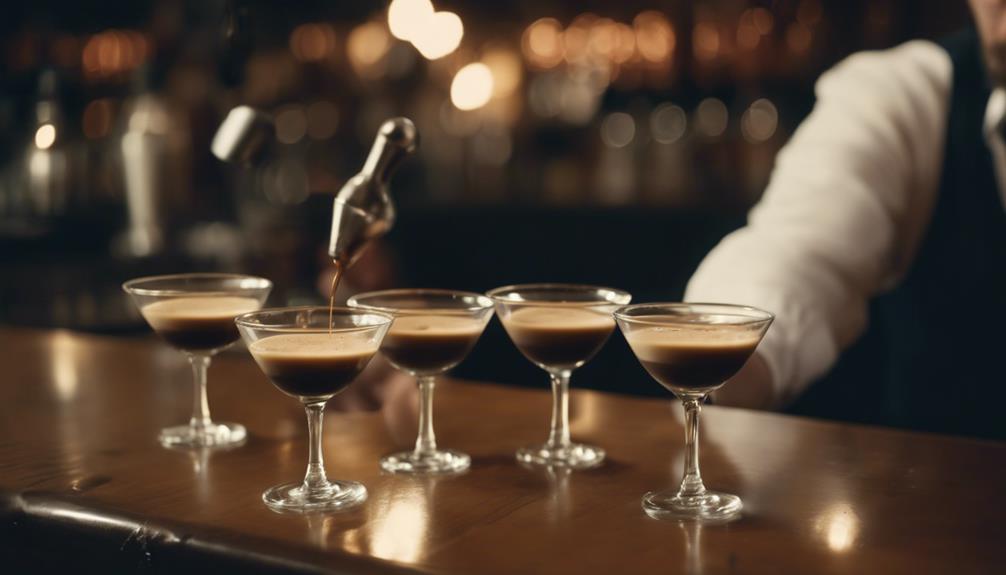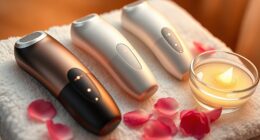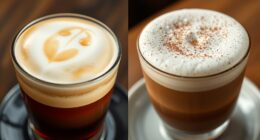You are about to receive a precise answer to a question that has been driving your daily routines: a standard 1-ounce shot of espresso contains approximately 63 milligrams of caffeine. This is more caffeine than what you will find in an 8-ounce cup of brewed coffee, which averages around 96 milligrams. However, did you know that factors such as the type of coffee beans, roast type, and grind size can affect the caffeine content? As you delve into the world of espresso, you will uncover more surprising facts that can help you maximize your energy boost and discover the best brewing methods to get the most out of your daily shot.
Key Takeaways
- A standard 1-ounce shot of espresso contains approximately 63 mg of caffeine.
- Espresso has higher caffeine content than an 8-ounce cup of brewed coffee, which averages around 96 mg.
- The type of coffee beans, roast type, grind size, brewing method, and amount of coffee used affect caffeine levels in espresso.
- A double shot of espresso yields around 125 mg of caffeine in 2 ounces, exceeding the caffeine content of a typical brewed coffee serving.
Caffeine Content in Espresso
When you order a shot of espresso, you can expect to get a concentrated dose of caffeine, with a standard 1-ounce serving packing approximately 63 milligrams of this stimulant. This amount of caffeine is considerably higher than what you'd find in a regular cup of coffee. The rich flavor and bold aroma of espresso is a result of the high pressure and quick extraction process used to brew it. This also means that the caffeine content in espresso is more concentrated, leading to a stronger and more immediate jolt of energy compared to a regular coffee. It’s important to be mindful of the caffeine content in espresso, especially if you are sensitive to or trying to limit your intake of this stimulant.
In fact, espresso has more caffeine than an 8-ounce cup of brewed coffee, which averages around 96 milligrams. If you opt for a double shot, also known as a doppio, you'll get around 125 milligrams of caffeine in just two ounces.
The caffeine content in espresso is largely due to the unique brewing methods used to make it. These methods result in a more concentrated beverage, which in turn leads to higher caffeine levels.
Whether you're looking for a quick energy boost or just need a pick-me-up, a shot of espresso is sure to deliver. With its high caffeine content, it's no wonder this beverage has become a staple in many people's daily routines.
Factors Affecting Caffeine Levels
You might expect a standard dose of caffeine in every shot of espresso, but the reality is that several factors can considerably impact the caffeine levels in your morning pick-me-up.
The type of coffee beans you use, for instance, plays a significant role in determining the caffeine content of your espresso.
- The type of coffee beans you use can greatly impact caffeine levels, with some varieties containing more caffeine than others.
- The roast type also affects caffeine concentration, with lighter roasts generally having slightly higher caffeine content than darker roasts.
These factors, along with the brewing method and the amount of coffee used, all work together to influence the final caffeine content of your espresso.
The brewing method, for example, can greatly impact the caffeine output, with espresso yielding a higher caffeine concentration per ounce compared to other methods.
Espresso Vs. Regular Coffee

As you compare espresso to regular coffee, you'll notice a significant difference in caffeine content.
You might assume that a larger cup of coffee would have more caffeine, but it's actually the concentration that matters – espresso packs a punch with around 63 mg of caffeine per ounce, while regular coffee has about 12 mg per ounce.
Now, let's take a closer look at how these numbers break down and what it means for your daily caffeine intake.
Espresso Caffeine Content
A standard shot of espresso packs a more intense caffeine punch than its brewed coffee counterpart, with approximately 63 milligrams of caffeine per ounce. You might be wondering why espresso has such a high concentration of caffeine. It all comes down to the brewing method and grind size of the coffee beans.
When you opt for a shot of espresso, you're getting a more concentrated amount of coffee in a smaller serving size. In comparison, an average 8-ounce cup of brewed coffee contains about 96 mg to 128 mg of caffeine.
Here are some key points to keep in mind:
- A double shot of espresso yields approximately 125 mg of caffeine, potentially exceeding the caffeine content of a typical brewed coffee serving.
- The brewing method greatly influences the caffeine content, with espresso extraction maximizing caffeine transfer in a shorter time.
Caffeine Per Ounce
When comparing espresso to regular coffee, the difference in caffeine concentration per ounce becomes strikingly apparent. Espresso boasts approximately 63 milligrams of caffeine per ounce versus regular coffee's 12-16 milligrams. This significant disparity is vital to understanding the amount of caffeine you're getting in each serving.
As you savor an espresso shot, you're consuming a more concentrated dose of caffeine, with about 40 milligrams per ounce, compared to regular brewed coffee's 10 milligrams per ounce. To put this into perspective, a double shot of espresso (2 ounces) packs around 125 milligrams of caffeine, surpassing the amount found in an 8-ounce cup of brewed coffee.
However, it's important to remember that the smaller serving size of espresso ultimately results in lower total caffeine intake compared to a standard cup of coffee. So, the next time you opt for an espresso or a cup of coffee, consider the amount of caffeine you're getting per ounce to make an informed choice about your daily caffeine intake.
Caffeine Perception and Health
As you savor your espresso, you might wonder why its caffeine kick affects you differently than others.
It's because your body's sensitivity to caffeine, how quickly it absorbs into your system, and your individual tolerance level all play a role in how you experience its effects.
Caffeine Sensitivity Factors
Your sensitivity to caffeine plays a notable role in determining how you perceive its effects, with some people feeling energized after a single shot of espresso while others need multiple servings to experience a similar boost.
This individual tolerance is influenced by various factors, including psychological factors such as expectations and past experiences with caffeine.
Your individual tolerance to caffeine can notably influence how you perceive its effects, leading to variations in how you react to the same amount of caffeine.
Psychological factors, such as expectations and past experiences with caffeine, can also affect your sensitivity and perception, making it a highly personalized experience.
The rapid consumption of espresso, compared to slower sipping of brewed coffee, can alter your perceived energy levels, further highlighting the complexity of caffeine sensitivity.
Caffeine Absorption Rate
The rapid absorption rate of caffeine in espresso, thanks to its high concentration and quick consumption, triggers a swift stimulant effect on your central nervous system. This is because espresso contains approximately 63 mg of caffeine per 1-ounce shot, which is notably higher than the 12-16 mg found in brewed coffee.
When you drink espresso, the caffeine is absorbed quickly into your bloodstream, causing a rapid increase in alertness and energy. In contrast, brewed coffee is sipped slowly, leading to a slower caffeine absorption rate. This difference in absorption rate affects how you experience the stimulant effects of caffeine.
As a result, you may feel more alert and focused after drinking espresso compared to brewed coffee. According to health recommendations, moderate caffeine consumption, including espresso, can be beneficial, with the FDA stating that up to 400 mg of caffeine daily is safe for healthy adults.
Individual Tolerance Levels
Individual factors, including genetics, lifestyle, and habitual consumption, considerably influence how you respond to caffeine from espresso, making your experience unique compared to others. Your individual tolerance to caffeine is shaped by these factors, affecting how you perceive the effects of a shot of espresso.
You may be more sensitive to caffeine, feeling a stronger caffeine jolt from a single shot, or you may need multiple shots to feel the same effects.
Your mindset and expectations can also influence your perception of caffeine's effects, making it feel stronger or weaker based on your prior experiences and expectations.
Additionally, if you're a regular coffee drinker, you may have developed a tolerance to caffeine, requiring higher doses to feel the same stimulant effects. This is important to take into account when determining your personal limits based on health recommendations.
Brewing Espresso for Optimal Caffeine
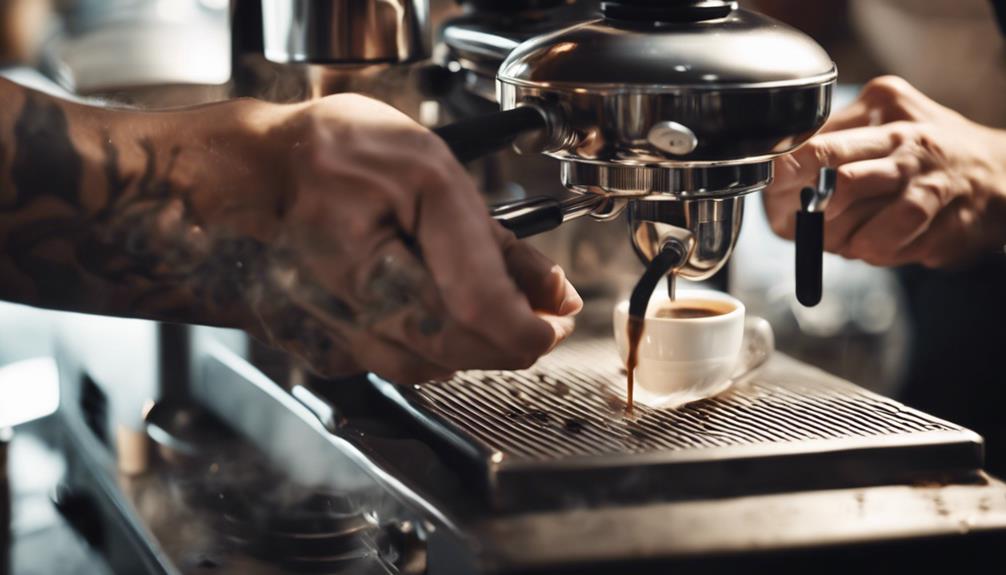
To brew espresso for ideal caffeine, you'll need to dial in the perfect combination of grind size, water temperature, and brewing time. The best grind size is fine, similar to table salt, which enhances caffeine extraction during the brewing process.
You'll want to use pressurized hot water at temperatures between 190°F to 205°F for the best results. Aim for an extraction time of 25 to 30 seconds to achieve ideal flavor and caffeine content.
The amount of coffee grounds you use directly influences caffeine levels, so don't be shy – use more coffee to increase the amount of caffeine extracted in each shot.
Consistency is key when it comes to brewing espresso for optimal caffeine. Make sure to maintain a uniform grind size and appropriate brewing time to maximize caffeine extraction.
Espresso Drinks and Caffeine Content
You're likely familiar with the caffeine kick from a single shot of espresso, but what about the caffeine content in popular espresso-based drinks? When you order a cappuccino, latte, or mocha, you're getting a boost of caffeine from the espresso shots used to make them.
Here's how the caffeine content breaks down in some popular espresso drinks:
- A cappuccino or latte typically contains 75 mg of caffeine for short/tall sizes and 150 mg for grande/venti sizes.
- A mocha can have varying caffeine levels, with 90 mg for short/tall sizes and up to 180 mg for venti sizes due to the addition of chocolate.
Keep in mind that these values are based on Starbucks' standard recipes, but caffeine content may vary depending on the coffee shop or barista.
Now that you know the caffeine content of your favorite espresso drinks, you can make informed choices to get the energy boost you need.
Caffeine Comparison by Brand
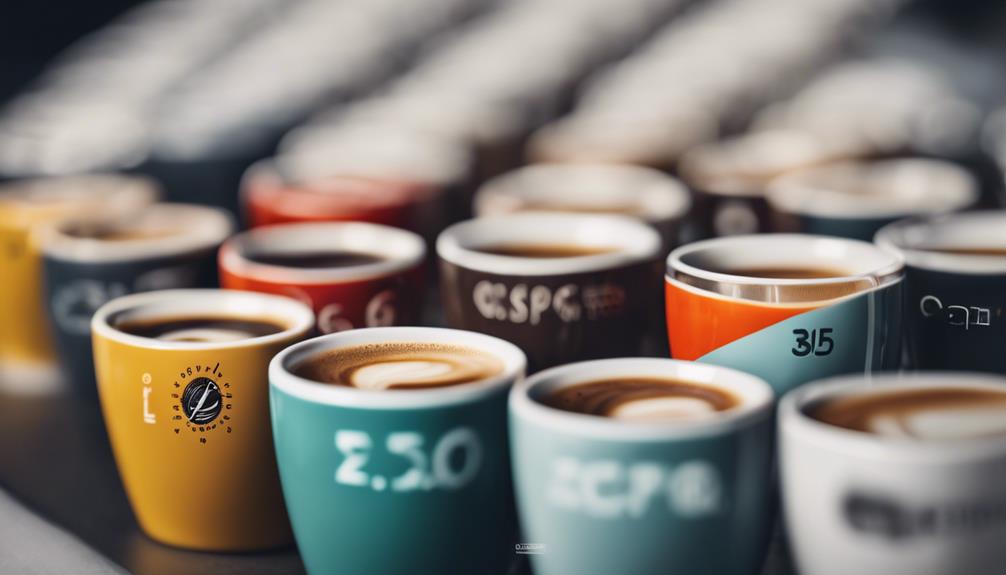
When comparing espresso shots from different brands, you'll find that the caffeine content can vary considerably, with some brands packing a stronger or weaker punch than others.
For instance, a standard 1-ounce shot of espresso typically contains around 63 mg of caffeine, but Starbucks serves a shot with about 75 mg of caffeine. This difference is largely due to the type of beans and roast levels used by each brand. On the other hand, a double shot of espresso, which is 2 ounces, will generally contain around 125 mg of caffeine. However, this can vary depending on the specific coffee beans and the brewing method. If you’re wondering how much caffeine in espresso double shot, it’s important to consider that it can range from 80 to 150 mg, again depending on factors such as roast level and bean type.
Specialty brands, in particular, can offer a wide range of caffeine levels in their espresso shots. Some artisan roasters might produce shots with as little as 50 mg of caffeine per ounce, while others might pack as much as 80 mg per ounce. This variance is vital to grasp, especially if you're trying to manage your caffeine intake.
When ordering a cup of espresso, it's important to keep in mind the brand and brewing methods used. A double shot of espresso at Starbucks, for example, provides around 150 mg of caffeine, demonstrating how serving size affects overall caffeine intake.
Health Benefits and Nutritional Value
Espresso's rich antioxidant profile and moderate caffeine content make it a surprising ally in your pursuit of better health and cognitive function. You might be surprised to learn that espresso is more than just a quick energy boost – it also offers several health benefits and a decent nutritional value.
Here are some of the ways espresso can benefit your health:
Antioxidant powerhouse: Espresso contains antioxidants that may help reduce inflammation and contribute to overall health benefits.
Cognitive function and physical performance: Moderate caffeine consumption, including from espresso, is linked to improved cognitive function and mental alertness, and may even enhance physical performance by increasing adrenaline levels and mobilizing body fat.
Essential nutrients: Espresso contains essential nutrients such as B vitamins and potassium, supporting various bodily functions and overall wellness.
As you enjoy your daily shot of espresso, remember that you're not only getting a caffeine kick but also reaping some amazing health benefits.
Coffee Consumption Trends and Insights

As you navigate the world of coffee, it's fascinating to explore the trends and insights that shape your daily habit. You're not alone in your coffee obsession – approximately 70% of Americans drink coffee weekly, with 62% consuming it daily.
Curiously, younger coffee drinkers aged 18-24 often pair coffee with breakfast, while older drinkers make it a staple for their morning routine. Regional preferences also influence espresso consumption habits, which in turn affect how people perceive caffeine's effects and develop their taste preferences.
What's more, there's a growing interest in specialty coffee among younger demographics, which might explain the varying consumption patterns based on caffeine needs. For instance, an 8-ounce cup of brewed coffee contains around 95 mg of caffeine, while a shot of espresso packs about 63 mg.
This disparity in serving size and caffeine content contributes to diverse consumption trends. As you brew your next cup or order a shot of espresso, consider how these trends and insights shape your coffee experience.
Frequently Asked Questions
How Much Caffeine Is in a Single Shot of Espresso?
You're wondering how much caffeine is in a single shot of espresso? Well, you'll typically get around 63 mg, but it can vary depending on the type of coffee bean and brewing method used. The caffeine content in espresso can also be influenced by the size of the shot and the brewing time. Generally, a double shot of espresso will have around 125 mg of caffeine. However, it’s important to note that espresso is more concentrated than regular coffee, so even though it has a higher caffeine content per ounce, you typically consume less volume of espresso compared to a regular cup of coffee.
Is 2 Shots of Espresso a Lot of Caffeine?
Are you ready for a caffeine boost like no other? Two shots of espresso pack a punch, delivering around 126 mg of caffeine – more than an average cup of brewed coffee!
Is 1 Shot of Espresso Equal to 1 Cup of Coffee?
You're wondering if one shot of espresso is equal to one cup of coffee. Not exactly – while a shot has 63mg of caffeine, a cup of coffee has 96mg, but the espresso's concentrated dose hits you faster.
What Is Considered 1 Shot of Espresso?
As you step into a cozy coffee shop, the aroma of freshly brewed espresso envelops you. You wonder, what is considered 1 shot of espresso? Typically, it's a 1-ounce serving, but some places, like Starbucks, measure it at 0.75 ounces.
Conclusion
You've reached the end of this caffeine-packed journey, but the real question remains: are you ready to take on the day with your newfound espresso knowledge?
With the facts in hand, you can now navigate the complex world of espresso like a pro.
But, be warned, there's still more to uncover – the perfect shot is just the beginning.
As you venture forth, remember, the next cup is always just around the corner, waiting to reveal its secrets…

